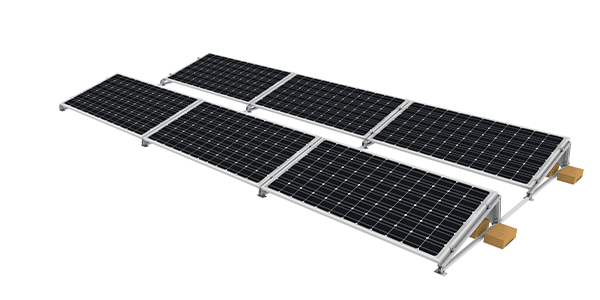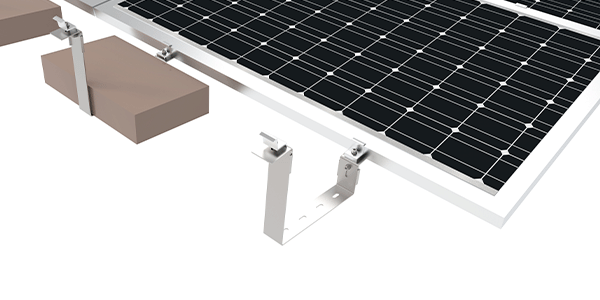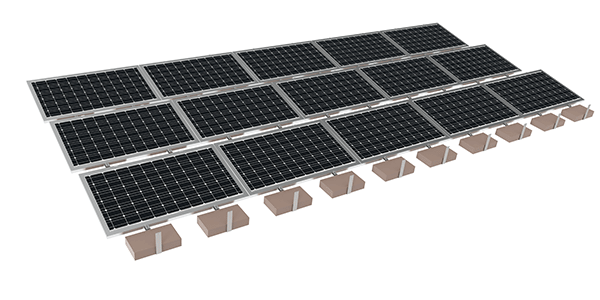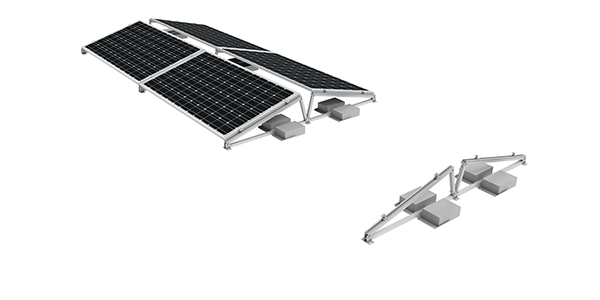As the demand for renewable energy grows, solar energy has become a cornerstone in the pursuit of sustainable and clean energy. Households, businesses, and government organizations are adopting solar modules to reduce environmental pollution and meet increasing energy demands.
The mounting structure of solar modules is a critical component, ensuring proper installation and optimal design angles to maximize solar exposure. Choosing the right mounting system is essential for long-term energy development. Below, we explore the structure of ballasted solar mounting systems, their importance, and their installation features.

About Ballasted Solar Mounting Structures
Ballasted solar mounting systems install photovoltaic (PV) modules on rooftops or ground surfaces without penetrating the roof. These systems use heavy materials, such as concrete blocks, to weigh down the mounting structure, eliminating the need for drilling or bolt connections, making installation more convenient.
In the context of solar mounting, “ballast” refers to using heavy materials as loads to ensure system stability. These systems are particularly suitable for flat rooftops or situations where roof penetration is not feasible.
Ballasted solar mounting systems typically have a fixed tilt angle of no more than 10 degrees. This design minimizes shading of the solar modules. A slight tilt also reduces wind effects on the modules, enhancing wind resistance. After installation, these systems add a controlled weight of 3 to 8 pounds per square foot to the roof, staying within the structural load limits.
Importance of Ballasted Solar Mounting Systems

Ballasted mounting systems primarily provide stability for PV arrays. During installation, ballast weights must be evenly distributed across the mounting structure to ensure balance. Proper ballast distribution prevents module movement, enhances structural integrity, and maintains the optimal orientation towards the sun. This contributes to improved energy output and overall solar performance.
Advantages of Ballasted Solar Mounting Systems
1. Convenient Installation
Ballasted systems can be installed quickly without drilling. Simply place the modules and mounting structure on the designated surface—whether a roof or ground—and use ballast to secure them. This reduces labor and equipment costs, making the installation process more efficient. Additionally, the system’s flexibility allows for easy adjustments or removal, accommodating various changing needs.
2. Minimal Impact and Easy Maintenance
Ballasted systems do not damage roof structures, minimizing risks such as leaks, corrosion, or structural damage. They also provide additional insulation and protection, reducing heat transfer and improving solar panel absorption efficiency. Maintenance is minimal—regular checks on ballast weight and alignment, as well as keeping the panels clean, are sufficient to maximize power generation.
3. Optimal Performance and Adaptability
Ballasted systems optimize the orientation and tilt of modules to maximize solar energy generation. Customizable layouts adapt to available space and allow aesthetically pleasing arrangements. These systems are compatible with various module types, sizes, and shapes, and can accommodate skylights or vents, reducing heat generation and enhancing energy yield.
4. Cost-Effective and Eco-Friendly
Ballasted systems offer economic benefits, lowering both initial and long-term costs associated with solar projects. With higher energy output and cost optimization, they deliver a faster return on investment. The reduction of resource consumption and waste aligns with carbon-neutral solar energy methods. Additionally, these systems preserve the integrity of installation surfaces, extending their lifespan and value.

Disadvantages of Ballasted Solar Mounting Systems
1. Weight and Stability
Ballasted systems rely on ballast weights for stability. It is crucial to carefully monitor the weight limits of individual components and the overall structure. Improper assembly may lead to instability, especially under external pressures such as snow loads. Understanding these limits and following proper assembly guidelines are essential for long-term performance and safety.
2. Wind Speed Considerations
High wind speeds pose challenges to ballasted systems, particularly those with limited tilt angles. Uneven rooftops can affect system stability and lead to damage. Roofs with significant slopes may create shading, reducing sunlight exposure and energy output. Integrating battery storage can enhance energy reliability during adverse weather or power outages.
3. Tilt Angle and Performance
The fixed tilt angle of ballasted systems may limit the system’s ability to withstand seasonal weather changes and optimize energy production year-round. With limited adjustability, maximizing energy production for different seasons becomes more challenging. While fixed-tilt systems typically require less maintenance, they offer less flexibility compared to adjustable mounting systems. Evaluating priorities such as solar potential and weather adaptability is key to determining the ideal tilt angle for your needs.
Key Considerations for Using Ballasted Solar Mounting Systems
When using a ballasted mounting system for your solar panels, several key factors must be considered:
Structural Capacity: Verify that your roof or ground can support the additional weight without compromising its structural integrity.
Roof Compatibility: Ensure the design prevents leaks and potential roof damage, especially for flat or load-bearing roofs.
Wind Uplift Resistance: Proper engineering and design are critical to counteract wind uplift forces. Techniques such as ballast calculations and additional roof attachments ensure stability during high winds or storms.
Tilt Angle and Orientation: Assess whether the roof’s tilt aligns with the solar potential and ideal panel direction for your location. Proper panel orientation significantly impacts daily sunlight exposure and energy output.
Ballast Selection and Placement: Choose suitable ballast materials (e.g., concrete blocks, gravel) and ensure even weight distribution.
Maintenance Requirements: Ensure the design allows safe and convenient panel access for repairs or cleaning. Consider safety measures for personnel working on the ballasted array.

Ballasted Systems vs. Ground-Mounted Systems
Both flat-mount systems have unique features. To decide between ballasted and ground-mounted systems, it’s essential to understand their respective methods of fixing solar panels, positioning them for optimal sunlight, and utilizing available land. These factors affect energy generation and installation costs, determining the most suitable system.
Ballasted Systems Provide a solution for roofs where drilling or penetration is not feasible.Rely on ballast to secure panels without anchors.Typically have fixed tilt angles, limiting seasonal adjustments.Ground-Mounted Systems,Offer greater adaptability with adjustable tilt angles for optimal sunlight absorption year-round.May require adherence to local land use regulations and environmental assessments.
Both systems must account for environmental factors such as wind, snow, and seismic activity, which vary by location.
Why Choose Leon Solar Solutions

Solar mounting systems involve various complexities. With over a decade of design experience, Leon Solar Energy Solutions provides expert advice for your solar installations. Our team ensures that mounting systems maximize solar panel efficiency while offering a solid foundation for long-term use. We can match materials to local conditions and design layouts to maximize sunlight absorption and energy conversion.
For commercial and industrial installations, ballasted mounting systems are a popular choice. We supply ballasted systems worldwide and offer installation recommendations. If you’re unsure about which mounting system suits your needs, feel free to contact us for professional advice and tailored solutions to ensure efficient and long-lasting solar performan.
